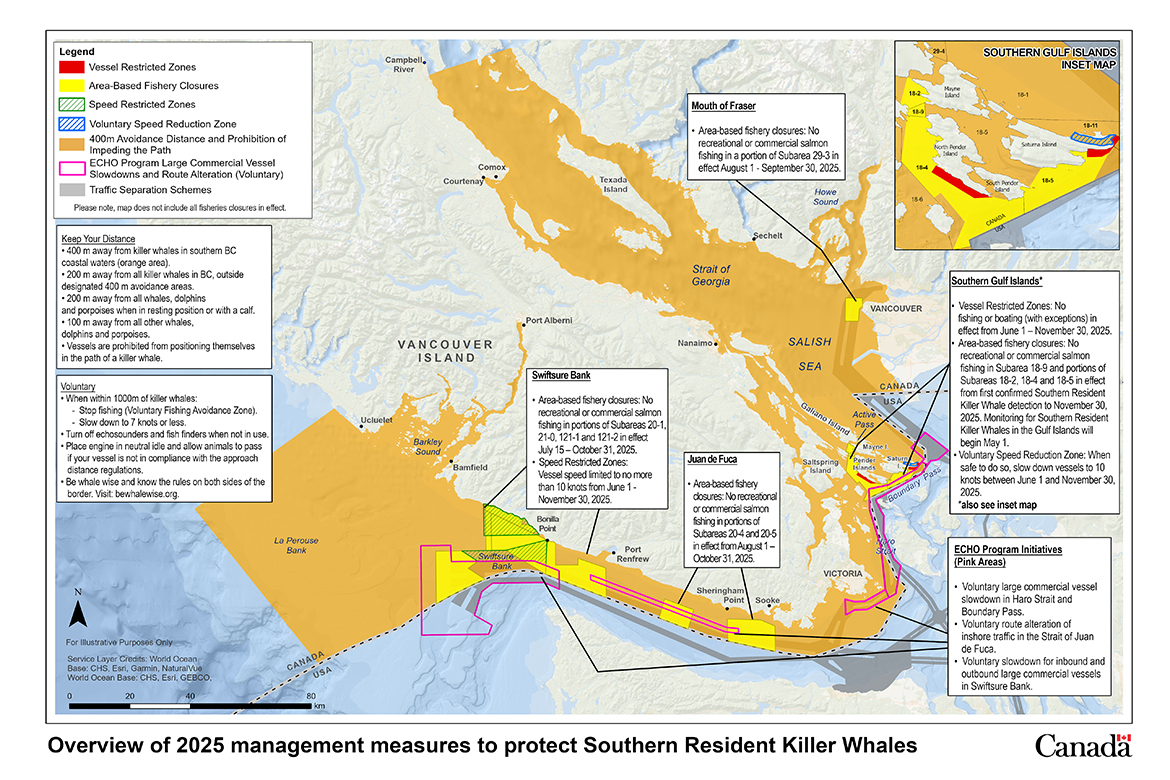PROTECT OUR MARINE MAMMALS
SOUTHERN RESIDENT KILLER WHALES
Southern Resident killer whales hold deep cultural importance for Indigenous Peoples and coastal communities across British Columbia. Imminent threat assessments conducted by the Government of Canada in 2018 and again in 2024 determined that this endangered population faces serious, immediate risks to its survival and recovery. Urgent and coordinated action is essential to protect them.
The three main threats to Southern Resident killer whales are:
- Declining availability and accessibility of prey
- Acoustic and physical disturbances
- Exposure to harmful contaminants
Canada has established laws and regulations to address these threats and help ensure the species’ survival. In addition to these measures, individuals can also take voluntary actions to support conservation efforts. Long-term protection and recovery of Southern Resident killer whales will require a sustained, collective commitment. These actions are informed by the latest science, and shaped through collaboration with First Nations, the Indigenous Multi-Nation Group, Indigenous and Multi-Stakeholder Advisory Group, Technical Working Groups, stakeholders, and feedback from public consultations.
Area-Based Fishing Closures
Chinook salmon are a critical food source for Southern Resident killer whales. However, wild Chinook populations have significantly declined over the past decade. While certain stocks—such as Fraser Summer 4.1—are showing signs of stability or growth, others, including Fraser Spring 5.2, remain at low abundance levels. To help increase Chinook availability in key foraging areas, specific fishery management measures are being implemented.
Southern Resident killer whales are a long-lived species, and despite some recent positive trends in Chinook numbers, consistent, long-term improvements are needed to ensure a reliable food supply. As a result, the following areas will be closed to salmon fishing for both commercial and recreational fishers:
- Swiftsure Bank: July 15 to October 31
- Parts of the Juan de Fuca Strait: August 1 to October 31
- Mouth of the Fraser River: August 1 to September 30
- Southern Gulf Islands: July 16 to November 30
Vessel Restricted Zones
Vessel Restricted Zones (formerly known as Interim Sanctuary Zones) are in effect from June 1 to November 30 to further limit acoustic and physical disturbances in important Southern Resident killer whale habitats.
During this period, vessel traffic—including fishing—is prohibited in zones near North Pender and Saturna Islands under the Interim Order of the Canada Shipping Act. Limited exceptions apply, including for emergencies, Indigenous food, social and ceremonial fisheries, or where Indigenous rights are being exercised.
There is also a voluntary speed reduction zone in Tumbo Channel, on the north side of Saturna Island, from June 1 to November 30. In this area, vessels should reduce their speed to no more than 10 knots, when safe to do so.
Speed Restricted Zones
Between June 1 and November 30, all vessels are required to slow down to a maximum of 10 knots in designated areas around Swiftsure Bank:
- In part of Subarea 121-1
In portions of Area 21 and Subareas 121-1 and 121-2, including the waters near the mouth of the Nitinat River from Carmanah Point to longitude 125 degrees west
- This is a mandatory measure and is separate from the voluntary slowdowns coordinated for large commercial vessels by the ECHO Program. Some limited exceptions may apply.
Avoiding whales
Until May 31, 2026, vessels must maintain a minimum distance of 400 metres and may not position themselves in the path of killer whales in southern BC coastal waters, from Campbell River to just north of Ucluelet. This rule is enforced under an Interim Order from the Canada Shipping Act.
Vessels flying a purple “Authorized Vessel” (AV) flag may operate closer to non-Southern Resident killer whales but must not follow them.
Marine Mammal Regulations continue to apply year-round, requiring the following minimum distances:
- 200 metres from all killer whales in Canadian Pacific waters not covered by the 400-metre rule
- 200 metres from whales, dolphins, and porpoises that are resting or accompanied by a calf
- 100 metres from all other whales, dolphins, and porpoises
Contaminants
The Government of Canada continues to take action to reduce contaminant-related threats to Southern Resident killer whales by strengthening and enforcing regulations, developing clear guidelines, engaging with stakeholders, and enhancing research and monitoring efforts. These initiatives have improved our understanding of the sources and levels of contaminants affecting both the whales and their prey, allowing us to better target prevention and mitigation strategies.
To support transparency and data sharing, information is made publicly available through the Open Government Portal and the Pollutants Affecting Whales and their Prey Inventory Tool (PAWPIT). PAWPIT is an interactive mapping tool that estimates pollutant releases from various sources within the habitats of Northern and Southern Resident killer whales, as well as freshwater areas important to Chinook salmon. The tool also highlights estimated ambient contaminant levels in the Fraser River Basin and identifies areas where environmental quality guidelines have been exceeded.
In addition, the Government of Canada continues to implement the Chemicals Management Plan, which includes ongoing monitoring, surveillance, and the development of controls for contaminants that pose a risk to Southern Resident killer whales.
Reference: 2025 management measures to protect Southern Resident killer whales
Protect Whales & Boat Safely — Take the Whale-Safe Boating Course 🐋
What is the Whale-Safe Boating Course? The Whale-Safe Boating Course is a free, online course designed for recreational boaters — whether you use a motorized boat, sailboat, kayak, or paddlecraft. It takes about 90 minutes and you can complete it at your own pace.
Why It Matters With? Growing whale populations along the BC coast and increased recreational boating activity, the risk of collisions, disturbance, and entanglement has risen. Many boaters are unsure of proper approach distances and legal requirements. This course bridges that knowledge gap by teaching responsible, lawful, and safe boating practices around marine mammals.
What You’ll Learn How to recognize whale blows, behaviour, and signs of marine mammal presence Current laws and approach-distance regulations Best practices to avoid collisions, reduce noise, and prevent gear-related injuries How and when to report marine mammal sightings and incidents Optional learning on local whale species, behaviour, and conservation challenges
What You Get:
- Certificate of completion
- Downloadable resources
- The confidence to boat responsibly in whale habitat
- The flexibility to complete the course on your own schedule
Learn more by clicking here.

